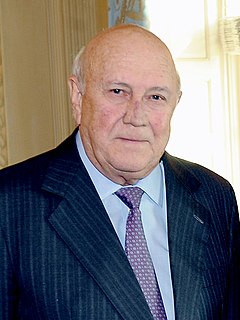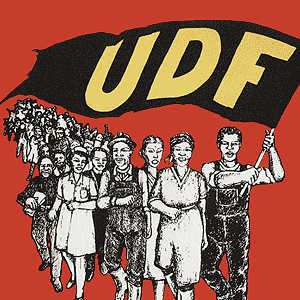
Frederik Willem de Klerk is a South African politician who served as State President of South Africa from 1989 to 1994 and as Deputy President from 1994 to 1996. As South Africa's last head of state from the era of white-minority rule, he and his government dismantled the apartheid system and introduced universal suffrage. Ideologically a conservative and an economic liberal, he led the National Party from 1989 to 1997.

The Krugerrand is a South African coin, first minted on 3 July 1967 to help market South African gold and produced by Rand Refinery and the South African Mint. By 1980, the Krugerrand accounted for 90% of the global gold coin market. The name is a compound of Paul Kruger, the former South African president depicted on the obverse, and rand, the South African unit of currency. During the 1970s and 1980s, some western countries forbade import of the Krugerrand because of its association with the apartheid government of South Africa, most notably the United States, which was the coin's largest market in 1985.

The first modern humans are believed to have inhabited South Africa more than 100,000 years ago. South Africa's prehistory has been divided into two phases based on broad patterns of technology namely the stone age and iron age. After the discovery of hominins at Taung and australopithecine fossils in limestone caves at Sterkfontein, Swartkrans, and Kromdraai these areas were collectively designated a World Heritage site. The first inhabitants of South Africa are collectively referred to as the Khoisan, the Khoi Khoi and the San separately. These groups were displaced or sometimes absorbed by migrating Africans (Bantus) during the Bantu expansion from Western and Central Africa. While some maintained separateness, others were grouped into a category known as Coloureds, a multiracial ethnic group which includes people with shared ancestry from two or more of these groups: Khoisan, Bantu, English, Afrikaners, Austronesians, East Asians and South Asians. European exploration of the African coast began in the 13th century when Portugal committed itself to discover an alternative route to the silk road that would lead to China. In the 14th and 15th century, Portuguese explorers traveled down the west African Coast, detailing and mapping the coastline and in 1488 they rounded the Cape of Good Hope. The Dutch East India Company established a trading post in Cape Town under the command of Jan van Riebeeck in 1652, European workers who settled at the Cape became known as the Free Burghers and gradually established farms in the Dutch Cape Colony.
Kwaito is a music genre that emerged in Johannesburg, South Africa, during the 1990s. It is a variant of house music featuring the use of African sounds and samples. Typically at a slower tempo range than other styles of house music, Kwaito often contains catchy melodic and percussive loop samples, deep bass lines, and vocals. Despite its similarities to hip hop music, Kwaito has a distinctive manner in which the lyrics are sung, rapped and shouted. American producer Diplo has described Kwaito as "slowed-down garage music," most popular among the black youth of South Africa.

"Nkosi Sikelel' iAfrika" is a Christian hymn originally composed in 1897 by Enoch Sontonga, a Xhosa clergyman at a Methodist mission school near Johannesburg. The song became a pan-African liberation song and versions of it were later adopted as the national anthems of five countries in Africa including Zambia, Tanzania, Namibia and Zimbabwe after independence. Zimbabwe and Namibia have since adopted new compositions for their national anthems. The song's melody is currently used as the national anthem of Tanzania and the national anthem of Zambia. In 1994, Nelson Mandela decreed that the verse be embraced as a joint national anthem of South Africa, with a revised version including elements of "Die Stem" adopted in 1997.

Anthony Terrell Seward Sampson was a British writer and journalist. His most notable and successful book was Anatomy of Britain, which was published in 1962 and was followed by five more "Anatomies", updating the original book under various titles. He was the grandson of the linguist John Sampson, of whom he wrote a biography, The Scholar Gypsy: The Quest For A Family Secret (1997). He also gave Nelson Mandela advice on Mandela's famous 1964 defence speech at the trial which led to his conviction for life.

David Bambatha Maphgumzana Sibeko, was known as the "Malcolm X of South Africa" and began his political career as a journalist for the black South African Magazine Drum. During his tenure with that magazine, he became a leading figure within the Pan Africanist Congress of Azania. During the 1970s he headed the United Nations Observer Mission of the Pan Africanist Congress (PAC) in New York City and used this position to popularize the PAC particularly among African-Americans. In 1979 Sibeko was partially successful in a leadership coup against Potlako Leballo. However he failed to get support from the Second Azanian People's Liberation Army, recruited from the 1976 student protest generation and was shot dead during an argument with them at his flat in Oyster Bay, Dar es Salaam, Tanzania on 12 June 1979.

Long Walk to Freedom is an autobiography written by South African President Nelson Mandela, and first published in 1994 by Little Brown & Co. The book profiles his early life, coming of age, education and 27 years in prison. Under the apartheid government, Mandela was regarded as a terrorist and jailed on the infamous Robben Island for his role as a leader of the then-outlawed ANC. He later achieved international recognition for his leadership as president in rebuilding the country's once segregated society. The last chapters of the book describe his political ascension, and his belief that the struggle still continued against apartheid in South Africa.

Apartheid was a system of institutionalised racial segregation that existed in South Africa and South West Africa from 1948 until the early 1990s. Apartheid was characterised by an authoritarian political culture based on baasskap, which ensured that South Africa was dominated politically, socially, and economically by the nation's minority white population. According to this system of social stratification, white citizens had the highest status, followed in descending order by Asians, Coloureds, and black Africans. The economic legacy and social effects of apartheid continue to the present day.

The Soweto uprising was a series of demonstrations and protests led by black school children in South Africa that began on the morning of 16 June 1976.

The United Democratic Front (UDF) was a major anti-apartheid organisation of the 1980s. The non-racial coalition of about 400 civic, church, students', workers' and other organisations was formed in 1983, initially to fight the new Tricameral Parliament. The UDF's goal was to establish a "non-racial, united South Africa in which segregation is abolished and in which society is freed from institutional and systematic racism." Its slogan was "UDF Unites, Apartheid Divides."

DRUM is a South African family magazine mainly aimed at black readers containing market news, entertainment and feature articles. It has two sister magazines: Huisgenoot and YOU.

Goodbye Bafana, or The Color of Freedom (US), is a 2007 drama film, directed by Bille August, about the relationship between Nelson Mandela and James Gregory, his censor officer and prison guard, based on Gregory's book Goodbye Bafana: Nelson Mandela, My Prisoner, My Friend. The film also explores the relationship of James Gregory and his wife as their life changes while Mandela is under Gregory's watch.
Nelson Mandela (1918−2013) was an anti-apartheid activist and former President of South Africa.
Boom Shaka were a pioneering kwaito music group from South Africa, consisting of Junior Sokhela, Lebo Mathosa, Theo Nhlengethwa and Thembi Seete. Their first album was produced in 1994. Boom Shaka's first single "It's About Time" was released in 1993. This track can be found on Stern's Music website. Boom Shaka became one of the most successful bands of the mid-1990s in South Africa and their music became the soundtrack for many young people in the newly democratic South Africa. Boom Shaka was able to break into the international market and achieved success outside of South Africa in London among other places.
Prior to the arrival of European settlers in the 15th century the economy of what was to become South Africa was dominated by subsistence agriculture and hunting.

Disinvestmentfrom South Africa was first advocated in the 1960s, in protest of South Africa's system of apartheid, but was not implemented on a significant scale until the mid-1980s. The disinvestment campaign, after being realized in federal legislation enacted in 1986 by the United States, is credited by some as pressuring the South African Government to embark on negotiations ultimately leading to the dismantling of the Apartheid system.
Nelson Mandela's electoral victory in 1994 signified the end of apartheid in South Africa, a system of widespread racially-based segregation to enforce almost complete separation of different races in South Africa. Under the apartheid system, South Africans were classified into four different races: White, Black, Coloured, and Indian/Asian, with about 80% of the South African population classified as Black, 9% as White, 9% as Coloured, and 2% as Indian/Asian. Under apartheid, Whites held almost all political power in South Africa, with other races almost completely marginalised from the political process.

Nelson Rolihlahla Mandela was a South African anti-apartheid revolutionary, political leader, and philanthropist who served as President of South Africa from 1994 to 1999. He was the country's first black head of state and the first elected in a fully representative democratic election. His government focused on dismantling the legacy of apartheid by tackling institutionalised racism and fostering racial reconciliation. Ideologically an African nationalist and socialist, he served as President of the African National Congress (ANC) party from 1991 to 1997.

The Carlton Hotel is a historic hotel in the Central Business District of Johannesburg, South Africa. It opened in 1972 as part of the enormous Carlton Centre complex, and has been closed since 1998.















